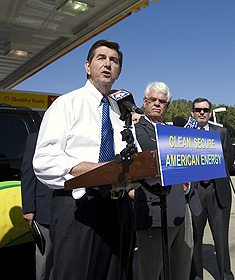 Farm implement maker New Holland announced today that it supports the use of 100 percent biodiesel in all equipment with New Holland-manufactured diesel engines. That would include electronic injection engines with common rail technology.
Farm implement maker New Holland announced today that it supports the use of 100 percent biodiesel in all equipment with New Holland-manufactured diesel engines. That would include electronic injection engines with common rail technology.
This press release from the company says it will help give customers a wider choice of equipment that uses the green fuel:
Overall, nearly 80% of New Holland-branded products with diesel engines are now available to operate on B100 biodiesel. New Holland has also asked other suppliers of diesel engines used in New Holland-branded products to test and approve higher levels of biodiesel.
In addition to extensive testing and development within the company, New Holland has been involved in an ongoing research project in collaboration with Penn State University to put B100 to the test under real-life conditions. Penn State’s College of Agriculture is operating new, unmodified New Holland tractors on B100 biodiesel on their 1,500-acre research farm to find out what diesel equipment owners can expect to experience when they use B100. After nearly two years of use, the tractors have performed with no adverse effects in performance or maintenance, according to Glen Cauffman, the university’s manager of farm operations and services.
Paul Trella, New Holland Director of Product Marketing for Under-100 HP Tractors, said that by supporting B100 use, New Holland is making a leap forward in its commitment to renewable energy. “We are committed to providing equipment that is compliant with biodiesel use, and to providing top-rate biodiesel support for our customers. As the use of biodiesel continues to gain greater acceptance and the infrastructure for providing a quality product to consumers, New Holland equipment is ready,” Trella said.
Company officials do stress that quality biodiesel from reputable dealers needs to be used in its equipment.


 The Missouri Soybean Association (MSA) is applauding the House of Representatives’ 361-54 override vote and the Senate’s 79-14 vote:
The Missouri Soybean Association (MSA) is applauding the House of Representatives’ 361-54 override vote and the Senate’s 79-14 vote: The statement was issued jointly by Gordon Quaiattini, President, Canadian Renewable Fuels Association, Canada; Robert Vierhout, Secretary General, European Bioethanol Fuel Association (eBIO), European Union; Bob Dinneen, President, Renewable Fuels Association (RFA), United States; and Marcos Jank, President, Sugar Cane Industry Association (UNICA), Brazil.
The statement was issued jointly by Gordon Quaiattini, President, Canadian Renewable Fuels Association, Canada; Robert Vierhout, Secretary General, European Bioethanol Fuel Association (eBIO), European Union; Bob Dinneen, President, Renewable Fuels Association (RFA), United States; and Marcos Jank, President, Sugar Cane Industry Association (UNICA), Brazil. The money is going to help Western Biodiesel Inc. build a plant near Aldersyde, Alberta that will crank out about five million gallons of biodiesel a year.
The money is going to help Western Biodiesel Inc. build a plant near Aldersyde, Alberta that will crank out about five million gallons of biodiesel a year.  Motorists traveling on Interstate 65 in Alabama will soon have the opportunity to fill up their vehicles on cleaner burning fuels produced in America.
Motorists traveling on Interstate 65 in Alabama will soon have the opportunity to fill up their vehicles on cleaner burning fuels produced in America. The greater Atlanta metro area officially welcomed its first E85 station station last week, thanks to help from General Motors,
The greater Atlanta metro area officially welcomed its first E85 station station last week, thanks to help from General Motors,  Georgia Governor Sonny Perdue welcomed a new phase in ethanol production to his state with
Georgia Governor Sonny Perdue welcomed a new phase in ethanol production to his state with  5. Micro Wind Turbine
5. Micro Wind Turbine